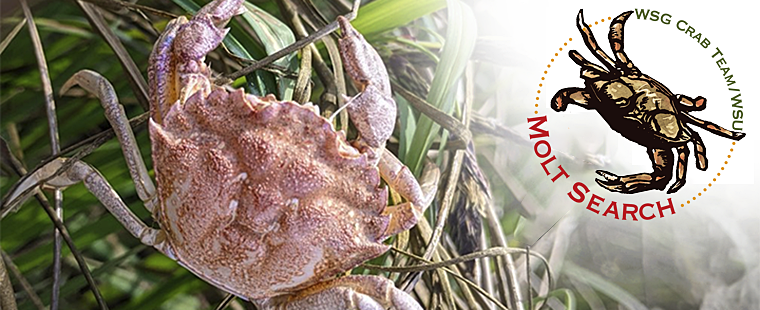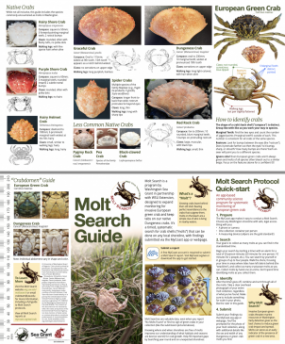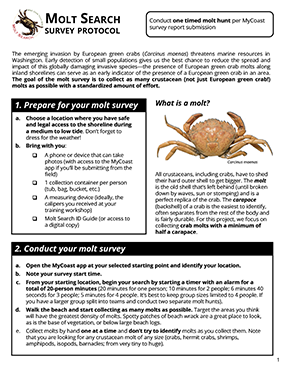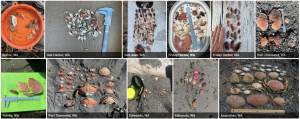The emerging invasion by European green crabs (Carcinus maenas) threatens marine resources in Washington. Early detection of small populations gives us the best chance to reduce the spread and impact of this globally damaging invasive species.
Washington Sea Grant and Washington State University Extension have teamed up to launch a new volunteer-based early detection program to complement the existing WSG Crab Team monitoring network.
Molt Search aims to support broader participation in early detection along inland Washington’s shorelines by teaching volunteers simple, standardized steps for searching and reporting on the presence (and absence!) of European green crab molts. Molts can serve as an early indicator of the presence of European green crab in a new area.
Additional data on native Dungeness crab molts adds value to search efforts by filling a significant knowledge gap on the range and growth patterns of juvenile Dungeness, whose preferred habitats overlap with the new invader.
Questions? Contact us at crabteam@uw.edu
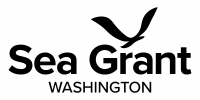
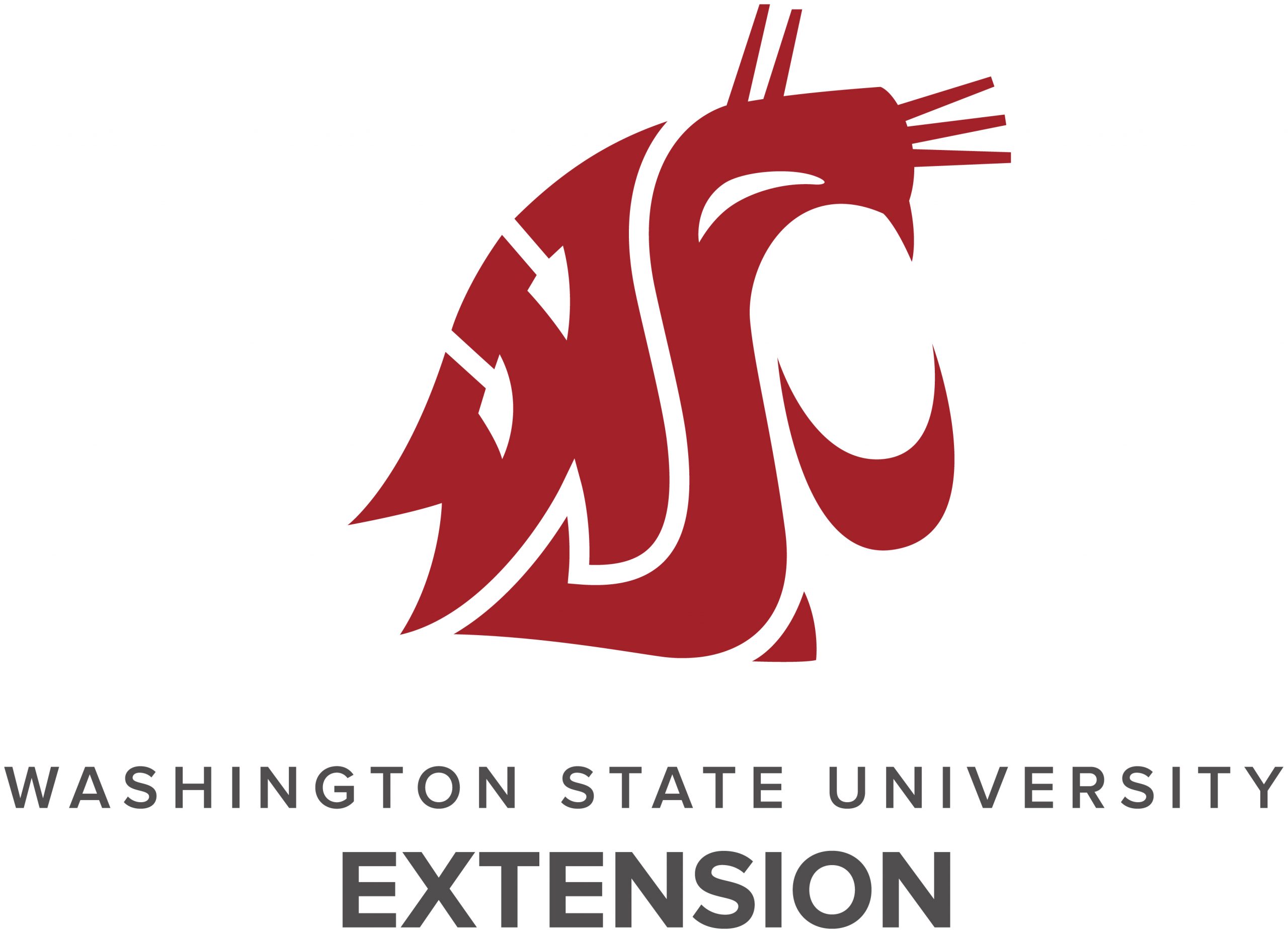
Resources
Molt Search Resources
Get started with MyCoast
Visit MyCoast Website
Download the MyCoast app for Apple or Andriod
Explore Molt Search reports on MyCoast
Calendar
Molt Search Events
Upcoming Events:
Salish Sea-wide Molt Blitz (June 20th)! Join Molt Searchers across the state in a single day data collection push by submitting a report from your local shoreline or joining one of our partner organizations’ staffers at a training or event on a shoreline near you. Location details below and on the event page: https://wsg.washington.edu/event/molt-blitz-2025/
Upcoming Trainings:
Fri. June 20, 9-11am (Thurston County): Training offered by Puget Sound Estuarium staff at Tolmie State Park. To register, please use this form.
Sat. June 21, 10am-noon (Whatcom County): Training offered by WSU Extension staff at Semiahmoo park. Drop in at 11am for guided practice if you’ve already been trained. Registration link here.
Sat. June 28, 1pm (King County): Training offered by Vashon Nature Center staff at Point Robinson as part of the annual Low Tide Celebration (11-3pm). More details & contact info here.
Molt Blitz Events (June 20th)*:
- Tolmie State Park (9-11am): Full Molt Search training hosted by Puget Sound Estuarium staff. Registration requested via this form
- Belfair State Park (9:30-noon) drop-in style hosted by Hood Canal Salmon Enhancement Group staff.
- Twanoh State Park (9:30-noon) drop-in style hosted by Hood Canal Salmon Enhancement Group staff.
- Seabeck Big Beef Pullout (10am) drop-in style hosted by Washington Sea Grant Crab Team staff. Location linked here.
- Silverdale Old Mill Park (12:30pm) drop-in style hosted by Washington Sea Grant Crab Team staff
- Edmonds Pier (10-noon) drop-in style hosted by Washington Sea Grant Crab Team staff
- Mukilteo Lighthouse Park (10-noon) drop-in style hosted by WSU Extension staff & Snohomish County Beach Watchers
- Padilla Bay NERR (10am) Full Molt Search training hosted by Padilla Bay NERR staff, 10am-noon, or drop by with questions
- Saltwater State Park (1:30pm) drop-in style hosted by Washington Sea Grant Crab Team staff
- Burien Seahurst Park (3:30pm) drop-in style hosted by Washington Sea Grant Crab Team staff
* Drop-in style trainings & practice allow welcome all, with opportunities to get your crab questions answered and Molt Search socially with your neighbors if you choose! Trainers will be stationed at a table near the shore or parking lot. More event details: wsg.washington.edu/event/molt-blitz-2025/
———
These public (free!) trainings are offered from April-September, hosted by a variety of trained local partners. They cover: 1) context/status of invasive green crab in Washington, 2) identification of native & invasive crabs, 3) Molt Search protocols & practice.
Have a neighborhood association or community group that would like to learn about European green crab and get trained on Molt Search protocols together? We are available, as staffing capacity allows, to support trainings for your local group. Send an email to crabteam@uw.edu to start the conversation!
Newsletter
Keep in touch!
The “Molt-o-Meter” newsletter announces upcoming events, program updates, and crab news (monthly, Spring-Fall):
Molt-o-Meter Past Issue Archive.
More
Molt Search activities are permitted in Washington State Parks under Scientific Research Permit #230603
Molt Search Frequently Asked Questions
How do I start Molt Searching?
Joining Molt Search takes just a few steps:
- Attend a training workshop. Held virtually and in-person across the region in summer months (see Volunteer events, above), trainings cover European green crab invasion background, crab identification, and Molt Search protocols.
- Create a MyCoast Account. This is where you’ll log your report, either via the app or the website.
- Find a shore, set a timer, do a Molt Search!
Where should I do a survey?
This program is designed to get more eyes on more shorelines to help managers detect new populations of green crab. For this reason, your surveys are most valuable on shorelines of Washington’s Salish Sea. Surveys from shorelines along Washington’s pacific coast may also help us compare known populations of green crab with molt patterns on shore. Molt Searches can be done on any shoreline where you have safe, legal access. Be aware of local collection and access regulations. Take a look at the map of where previous Molt Searches have been submitted. The more coverage, the better!
Note: Molt Searches are welcome on Washington State Park shorelines, too! Scientific Research Permit #230603 covers these activities.
When should I do surveys?
Surveys are welcomed from any time of day or year. Because molts are a result of crabs outgrowing their shell, you’ll likely find more during warmer months (May-October) when crabs are growing more quickly. You are welcome to conduct Molt Searches as frequently or seldom as you’d like. A monthly survey from a shoreline near you would be a great contribution to the dataset!
Can my friends join me on a Molt Search?
Yes! Molt Searches can be done in teams of up to 4 people, and only one of those must be trained. To help us maintain our data integrity, anyone who hasn’t yet attended a volunteer monitoring workshop should rely on a trained volunteer to direct the search and submit the group’s report via their MyCoast account. Have fun working together to gather and identify all the molts you can find!
If your friends want to do more molt searches on their own, help them find an upcoming training to learn how to submit their own data.
How do I know if I've found a molt or a dead crab?
Because we’re interested in the presence or absence of Dungeness and green crabs, don’t fret too much about this distinction.
If you’re unsure, feel free to submit additional photos of the individual in question with your report and add any notes or observations in the Field Notes/Comments section on the last page of the MyCoast reporting form. Sometimes it can be tricky to tell if the shell in your hand is a molt or dead crab. To get to the bottom of it, we’ve outlined four questions you can ask yourself:
- Is there any obvious trauma? Some predators will leave specific clues behind after munching on crab shells. Looking for these clues may help you distinguish between a molt or a dead crab that met an unfortunate demise.
- How heavy is it? Molts are typically much lighter than dead crabs with tissue still in-tact.
- Does it open? Because molting crabs essentially climb out the back of their shells, the shell of a molt should easily open on a hinge (much like a jewelry box). If it’s hard to open, it’s likely a dead crab.
- What’s inside? Molted shells should be quite clean inside, while dead crabs may contain goo or crust of internal tissue. Remember that feathery gill tissue appears in molts too.
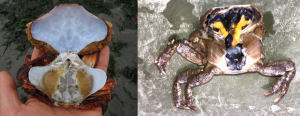
A molt (left) will have a clean shell interior, and open like a jewelry box hinging at the eyes. A dead crab (right) may be filled with “goo” of various colors in the middle section of the shell and attached to the inside of the carapace. Note that both crabs appear to have gills, while the molt actually only has the molted coverings of the gills. Photos Jeff Adams and Emily Grason
Curiosity piqued? Read even more in this WSG Crab Team blog post.
What if I find a species I can't identify?
The Molt Search ID guide (above) has many of the species that we think you are likely to see in your molt surveys, but it doesn’t include everything and every beach is different. It also can take some practice to feel confident in your species identifications!
If you find anything you can’t identify, make sure the molt is in your collection photo and leave us a note in the Field Notes/Comments section on the last page of the MyCoast reporting form. You can also include an additional, close-up photo of your mystery molt.
Can I edit a report after I submit it?
You can edit or delete reports from your computer via the MyCoast website. From there, log in to your MyCoast account and then use the top menu bar to navigate to “My Account” > “My Reports” to view, edit, and delete your submitted reports. If you have trouble, feel free to send us an email (crabteam@uw.edu) with any notes or amendments.
What happens to my data after I submit my survey?
Each and every report you submit gets monitored by Washington Sea Grant staff for reports for European green crab findings. Visit https://mycoast.org/wa/crab to view all the new reports coming in.
Whether or not a report includes green crab, the locations of Molt Searches will be included in annual planning conversations where Washington Sea Grant works with WDFW and local partners to best distribute limited monitoring resources across the region. It’s important to know where searches have yielded no evidence of green crab presence, so that search effort can instead be focused on locations that have yet to be explored.
All confirmed detections of European green crabs in a new water body will be directly communicated to WDFW and relevant local partners. From there, managers may initiate a follow-up trapping effort to determine the extent of the location population. Based on the outcome of that assessment, managers and scientists discuss what ongoing efforts may be appropriate for the site—ranging from continued monitoring, repeated assessments, or intensive control trapping. Learn more about how European green crabs are managed in Washington at WDFW’s European Green Crab Hub.
How can my group host a Molt Search training?
We are currently developing our plans to further expand our workshop offerings. There are currently two ways your group can hold a local Molt Search training.
- Send a representative to our annual train-the-trainers workshop, where they’ll learn how to organize a public-facing Molt Search workshop and teach these protocols in your local community. Workshops given by facilitators who attend a “train-the-trainers” are supported by Molt Search advertising and materials.
- On a limited basis and with some date coordination, Molt Search staff can send a trainer to your group’s meeting.
Start a planning conversation by sending us an email: crabteam@uw.edu
Molt Search In The News
Crab Team Blog Green crab molt found in False Bay, San Juan Island (June 9, 2025)
Fox 13 Training sessions to detect European green crabs are now available (June 2, 2025)
Everett Harold “Help Washington manage European green crabs with citizen science events” (May 31, 2025)
Whidbey News-Times “Citizen scientists on the prowl for invasive crab” (July 19, 2024)
The Olympian: “One of the worst invasive species threatens WA waters. Here’s what to do if you see it” (July 8 2024)
KUOW, Seattle Now: “Looking for crab molts to stop invasive green crabs” (June 24 2024)
Seattle Times: “Help search for invasive crab during the Salish Sea-wide Molt Blitz” (June 17 2024)
SEAToday: “Collect important data on invasive crabs for state researchers” (June 17 2024)
Everett Harold: “Learn how to spot invasive crabs this month in Snohomish, Edmonds” (June 9, 2024)
Skagit Valley Herald: “Volunteers taught how to identify invasive green crabs” (June 11 2023)
San Juan Journal: “Green Crab community science opportunity” (May 5 2023)
KUOW: “Volunteers needed to defend Washington against the green crab invasion” (May 3 2023)
WSU CAHNRS News: “Amid emergency measures, WSU Extension and Washington Sea Grant train volunteers to find invasive European green crab” (April 18 2023)
WSG Crab Team has many more resources about green crab background and identification. Here are a few that may be of interest to you:
